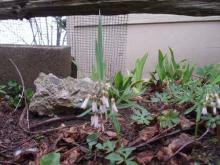I've had the following request out on the SRGC forum for some time without much luck. I'll try again here - these are seldom or never offered in the seedexes. I understand that seed is ripe quite early in the year:
"I am looking for various North American Toothworts (Dentaria spp) such as Dentaria laciniata, multifida, heterophylla, diphylla, californica, tenella, pucherrima, gemmata, nuttallii etc. Can anyone help?
Pay or trade."
Comments
Re: North American Dentarias (Toothworts)
I hope you have more success here in the "home of these plants, Stephen.... I can't say I know of many growing them in the UK.
Re: North American Dentarias (Toothworts)
Stephen, you know that Dentaria and Cardamine are synonyms? You can find several of the plants by looking at Cardamine laciniata etc ;)
Yes, thanks for pointing that out, Trond! I was aware of this and have searched for both in the seedexes. It seems that they are all now classified as Cardamine, but Dentarias are different in having fleshy(edible) rhizomes which the bittercresses (Cardamine) do not. I thought people would be more familiar with the name Dentaria...
Re: North American Dentarias (Toothworts)
I thought you would know; Stephen ;D
I grow several Cardamines but not any American. I sowed californica this spring and 2-3 have germinated and grow as cress ;D Seem they will flower this summer!
The showiest is this pentaphylla though.
Re: North American Dentarias (Toothworts)
So, you do now have an American Cardamine! Where did you get seed?
I have seedlings of Cardamine douglasii and pensylvanica - the latter looks like it would be very weedy like hirsuta...
Pentaphyllos and macrophylla are the most floriferous ones here so far...
Re: North American Dentarias (Toothworts)
"I am looking for various North American Toothworts (Dentaria spp) such as Dentaria laciniata, multifida, heterophylla, diphylla, californica, tenella, pucherrima, gemmata, nuttallii etc. Can anyone help?
Pay or trade."
I'll put you on my list for Cardamine laciniata seed, too, Stephen. It certainly does seed early: last year I was too late when I went to collect seed. I will email you when the time is near. No other Cardamine spp. are native here, and I don't have any other in the garden either.
Re: North American Dentarias (Toothworts)
Thanks for that, appreciate it!
Re: North American Dentarias (Toothworts)
Hi Stephen: Have tried twice already to send you a note about Dentaria in my garden plus a picture - it's been so long since I did this that I guess I need a refresher course. Anyway, we'll skip the words and see if the picture will go through this time. Fran
Frances Howey
London, Ontario, Canada
Zone 5b
Re: North American Dentarias (Toothworts)
So, you do now have an American Cardamine! Where did you get seed?
Yes but not in the garden yet! I got seed from Nargs of course ;D!I have seedlings of Cardamine douglasii and pensylvanica - the latter looks like it would be very weedy like hirsuta...
Pentaphyllos and macrophylla are the most floriferous ones here so far...
Here is Cardamine waldsteinii - also a charming shade tolerant plant in flower now. I think it has the hugest flowers of the genus.
Re: North American Dentarias (Toothworts)
I'm not sure how to frame this question, but since Cardamine laciniata is the only one I am familiar with,
are all cardamine species ephemeral?
Any experience with self fertility/infertility?
Re: North American Dentarias (Toothworts)
I'm not sure how to frame this question, but since Cardamine laciniata is the only one I am familiar with,
are all cardamine species ephemeral?
Any experience with self fertility/infertility?
All Cardamines I have are more or less ephemeral. However, if the summer is moist some of them keep their leaves for a long time.
C pentaphyllos, enneaphyllos and waldsteinii seem to be self-incompatible as they never or seldom set seed (have only one clone of each). Heptaphylla sets plenty of fertile seed and bulbifera sets lots of bulbils. Pratensis is so common that they always produce seed and even parts of leaves and stem can root.


Stephen, you know that Dentaria and Cardamine are synonyms? You can find several of the plants by looking at Cardamine laciniata etc ;)